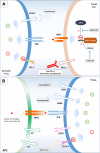Immunotherapy in small-cell lung cancer: from molecular promises to clinical challenges
- PMID: 31383005
- PMCID: PMC6683488
- DOI: 10.1186/s40425-019-0690-1
Immunotherapy in small-cell lung cancer: from molecular promises to clinical challenges
Abstract
Management of small cell lung cancer (SCLC) has not changed over the last decades. In more recent years, alterations of DNA repair machinery and other molecular pathways have been identified in SCLC and preclinical data suggest that dysregulation of these pathways might offer new therapeutic opportunities.While immune checkpoint inhibitors (ICIs) have had a major impact on the clinical outcome of several solid tumors, including non-small cell lung cancer, the potential role of ICIs is currently under investigation in SCLC and some promising data are available. However, several clinical and biological hurdles have to be overcome and predictive markers are still eagerly needed. Knowledge of molecular pathways specifically involved in SCLC growth and treatment resistance is essential for a more rational planning of new combinations including ICIs.The present manuscript summarizes the current clinical evidence on immunotherapy in SCLC, describes the molecular bases underlying treatment resistance and discusses the potentialities and the rationale of different therapeutic combinations.
Keywords: Combination therapy; Enhancer of zeste homolog 2; Immune checkpoint inhibitors; Immunotherapy; Small cell lung cancer; Tumor microenvironment.
Conflict of interest statement
The authors declare that they have no competing interests.
Figures


Similar articles
-
Emerging drugs for small cell lung cancer: a focused review on immune checkpoint inhibitors.Expert Opin Emerg Drugs. 2020 Sep;25(3):353-366. doi: 10.1080/14728214.2020.1798929. Epub 2020 Aug 4. Expert Opin Emerg Drugs. 2020. PMID: 32683991 Review.
-
Challenges in the treatment of small cell lung cancer in the era of immunotherapy and molecular classification.Lung Cancer. 2023 Jan;175:88-100. doi: 10.1016/j.lungcan.2022.11.014. Epub 2022 Nov 23. Lung Cancer. 2023. PMID: 36493578 Review.
-
Targeted Therapy and Immune Therapy for Small Cell Lung Cancer.Curr Treat Options Oncol. 2018 Sep 10;19(11):53. doi: 10.1007/s11864-018-0568-3. Curr Treat Options Oncol. 2018. PMID: 30203184 Review.
-
Prolonging Survival: The Role of Immune Checkpoint Inhibitors in the Treatment of Extensive-Stage Small Cell Lung Cancer.Oncologist. 2020 Nov;25(11):981-992. doi: 10.1634/theoncologist.2020-0193. Epub 2020 Sep 23. Oncologist. 2020. PMID: 32860288 Free PMC article. Review.
-
The Future of Immunotherapy in the Treatment of Small Cell Lung Cancer.Oncologist. 2016 Aug;21(8):910-21. doi: 10.1634/theoncologist.2015-0523. Epub 2016 Jun 27. Oncologist. 2016. PMID: 27354668 Free PMC article. Review.
Cited by
-
Anlotinib for patients with small cell lung cancer and baseline liver metastases: A post hoc analysis of the ALTER 1202 trial.Cancer Med. 2022 Feb;11(4):1081-1087. doi: 10.1002/cam4.4507. Epub 2021 Dec 23. Cancer Med. 2022. PMID: 34939373 Free PMC article. Clinical Trial.
-
Diagnostic and prognostic nomograms for bone metastasis in small cell lung cancer.J Int Med Res. 2021 Oct;49(10):3000605211050735. doi: 10.1177/03000605211050735. J Int Med Res. 2021. PMID: 34693779 Free PMC article.
-
Establishing CD19 B-cell reference control materials for comparable and quantitative cytometric expression analysis.PLoS One. 2021 Mar 19;16(3):e0248118. doi: 10.1371/journal.pone.0248118. eCollection 2021. PLoS One. 2021. PMID: 33740004 Free PMC article.
-
Immunotherapy era in the treatment of small cell lung cancer.Med Oncol. 2021 Jun 22;38(7):86. doi: 10.1007/s12032-021-01535-5. Med Oncol. 2021. PMID: 34156575 Review.
-
Identification of HEPACAM2 as a novel and specific marker of small cell carcinoma.Cancer. 2025 Jan 1;131(1):e35557. doi: 10.1002/cncr.35557. Epub 2024 Sep 20. Cancer. 2025. PMID: 39301750 Free PMC article.
References
-
- Nicholson AG, Chansky K, Crowley J, Beyruti R, Kubota K, Turrisi A, et al. The international association for the study of lung cancer lung cancer staging project: proposals for the revision of the clinical and pathologic staging of small cell lung cancer in the forthcoming eighth edition of the TNM classification for lung cancer. J Thorac Oncol. 2016;11(3):300–311. - PubMed
-
- Sundstrom S, Bremnes RM, Kaasa S, Aasebo U, Hatlevoll R, Dahle R, et al. Cisplatin and etoposide regimen is superior to cyclophosphamide, epirubicin, and vincristine regimen in small-cell lung cancer: results from a randomized phase III trial with 5 years’ follow-up. J Clin Oncol. 2002;20(24):4665–4672. - PubMed
-
- Takada M, Fukuoka M, Kawahara M, Sugiura T, Yokoyama A, Yokota S, et al. Phase III study of concurrent versus sequential thoracic radiotherapy in combination with cisplatin and etoposide for limited-stage small-cell lung cancer: results of the Japan clinical oncology group study 9104. J Clin Oncol. 2002;20(14):3054–3060. - PubMed
-
- Society AC. Cancer Treatment and Survivorship Facts & Figures 2014–2015 2014.
-
- National Cancer Institute, Surveillance, Epidemiology, and End Results program (SEER). Available online. Surveillance, Epidemiology, and End Results program (SEER) [cited 2018]. Available from: https://seer.cancer.gov/archive/csr/1975_2012/browse_csr.php?sectionSEL=....
Publication types
MeSH terms
LinkOut - more resources
Full Text Sources
Medical
